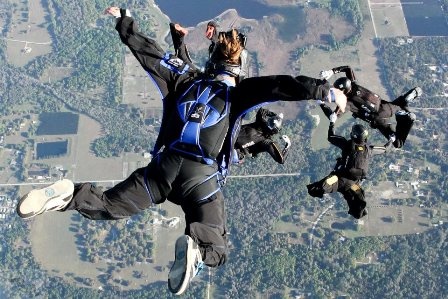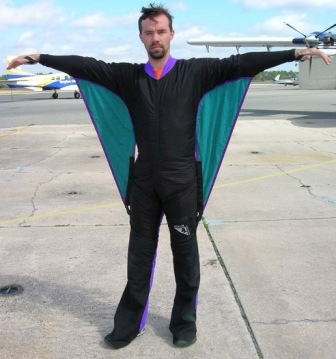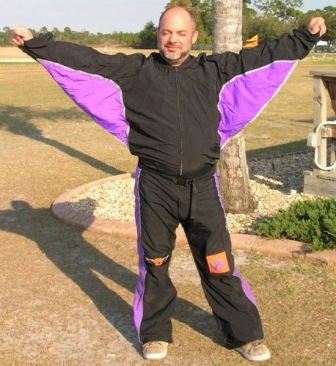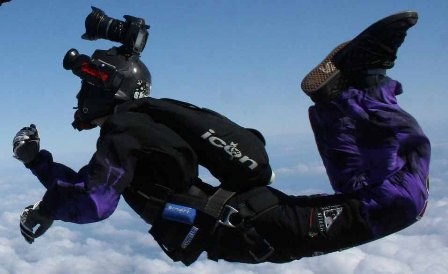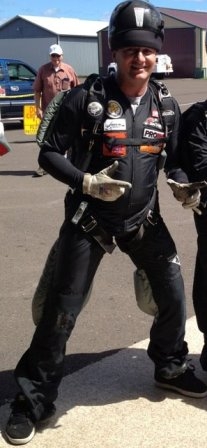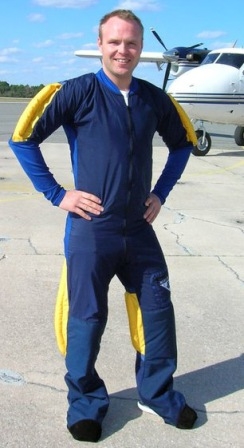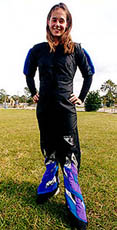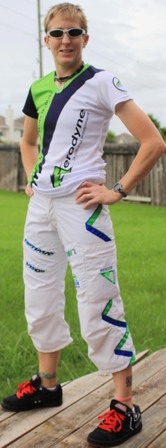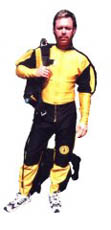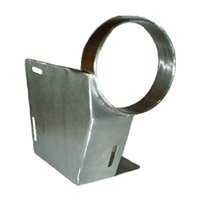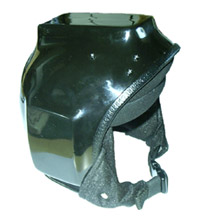-
Content
-14 -
Joined
-
Last visited
-
Days Won
1 -
Feedback
0%
Content Type
Profiles
Forums
Calendar
Dropzones
Gear
Articles
Fatalities
Stolen
Indoor
Help
Downloads
Gallery
Blogs
Store
Videos
Classifieds
Everything posted by admin
-
Believe it or not, this is how Merlin Suits truly came to be. We're going way back folks!!! The first was made back in 1991 for Patrick de Gayardon. He continued to jump Merlin Suits for many of his needs until his tragic passing in 1998. He enabled Merlin Suit to discover what was really needed in the aspects of sky surfing. Over the years we have tried many different thing for customers with their own ideas on suits and in the end the original always came through with flying colors. Made with or without a zero porosity shell, they include vented arms that create a very stable and consistent suit. They are basic suits that are brought to life with your creative mind. We also offer both spandex and baggy pants that accompany the suits.
-
This suit is designed specifically with the team camera people in mind. We build it to the same specification as the Pro, Comp. Suit less the grippers and their reinforcing and give you choice of wing size.These are just the standard configurations that we offer you. Your suit choice can be combined with almost any wing type. All you need to do is let us know what your needs are.
-
This suit is the same as the basic camera, but with short legs. This is a great suit for those hot summer days when you don't have time to take you suit on and off all day.
-
-
-
-
Our Competition Suit is wonderful for the current and active jumpers looking for a great suit, which not only fits their needs, but also is reasonably price. The Comp. Suit comes with both inseam and outer leg grippers that are slightly larger then the RW Suit. Grippers are made from cordura, as are the booties and bum. There is a soft padding in the knees and reinforcing across the leg grippers.
-
Merlin Suits would like to introduce the new Pro Competition RW Suit. This is, quite simply, the finest belly flying suit that you can buy today. Engineered for world-class belly flying by people who actually use the suits, the COMP suit represents the cutting edge in competition RW Suits. The COMP RW was designed with assistance from the Performance Factory Teams and Deland Genesis and represents the ongoing improvements that stems from 4 1/2 years of training and 20,000+ jumps in the product. In addition to all the features on the Comp suit we have added webbing rigidity to our booties while still offering your choice of Para Pac or cordura booties. They include a fully enclosed leather toe which holds it's own on those long swoops. Also we have added 3/8-inch foam to the kneepads making a more comfortable and better-fitted kneepad. The Pro. Comp. Suit still has those wonderful cordura grippers, but they are 1/2 inch deeper to the grip pocket and fuller than the Comp. Suit. With reinforcing between the leg grippers we have added bar tacking to each end of the legs gripper, also adding reinforcing elbow to elbow between the arm grips. The arms grips are now equal girth with the leg grips and sit higher off the arm for better gripping. Double spandex sides now offer a snugger fit while adding more durability to the suit. There is cordura reinforcing from the crotch area down to the knees, which helps reduce wear and tear on the suits due to leg strap friction.
-
-
Merlin Suits has done extensive research in finding what really works for Freefliers. We design our suits to the individual according the their height, weight and discipline. Our freefly suits offer a variable range without having to add too much or take too much fabric from the suit. We offer a large range of designs along with the ability to bring you designs to life. There are always a wide variety of fabrics and tie-dye choices and we will be happy to use your fabric or look for something special for you. The Freefly Suits include a Velcro sandwich ankle cuff, snap on the zipper, choice of spandex or Velcro wrist cuffs, a large pocket inside the suit, and one on the leg.
-
These pants are similar to free-fly pants. They Have elastic at the ankles, padded knees, and a Handy thigh pocket for stow bands, etc.
-
Our standard free-fly jacket is constructed of medium weight poly/cotton poplin. It offers variable arm width for your specific flying needs. Standard features include Spandex waist and collar, zipper front and Velcro closures at wrists.
-
Our standard free-fly jumpsuit and pants are made of medium weight poly/cotton poplin. The legs are fairly snug at the upper thigh with increasing bagginess to the ankle. Both arms and legs are designed in width and length to meet your specific fall-rate requirements. A medium weight poly/cotton suit is not the right weight for you?
-
Our standard free-fly jumpsuit and pants are made of medium weight poly/cotton poplin. The legs are fairly snug at the upper thigh with increasing bagginess to the ankle. Both arms and legs are designed in width and length to meet your specific fall-rate requirements. A medium weight poly/cotton suit is not the right weight for you? Contact us with your specific needs and we will design a jumpsuit that will maximize your air performance!!
-
Our standard Camera Suit features a lined ripstop front and arms, poly/cotton and spandex back, booties and either a small or large nylon wing. One option with this suit is an added system to interchange wings. If grippers are added to this suit, it can double as an RW suit if designed with the interchangeable wing system.
-
-
Today, Sky Venture announced its acquisition of TunnelCamp.com and the construction of Sky Venture Arizona. Alan Metni, former Arizona Airspeed member and owner of TunnelCamp.com, will join Sky Venture as its CEO. Sky Venture also made public its immediate expansion into new markets with tunnels slated for construction in Southern California, New Jersey, Chicago and Texas. Sky Venture recently begun franchise operations in Malaysia and is building a tunnel in the UK for its military. The company has the capacity and financial ability to build multiple units simultaneously. Sky Venture Arizona - a second generation Vertical Wind Tunnel located just outside Phoenix - will be less than 20 minutes drive from Sky Harbor Airport and 45 minutes from Skydive Arizona. Site selection, financing and design are complete and the company has begun fabrication of the enormous steel superstructure and components. Sky Venture Arizona will reportedly be faster, smoother and quieter than previous Sky Venture tunnels and superior to any other known design. Sky Venture Arizona will produce 45% more horsepower than its Florida predecessor and will be optimized for the sport skydiving and military markets (as part of the expansion plan, the Florida tunnel will also undergo substantial upgrades). Sky Venture has filed for additional patents on many of the improvements. Bill Kitchen is the inventor of the Sky Venture Vertical Wind Tunnel and the majority owner of Sky Venture. Kitchen built Sky Venture Florida as a working prototype in 1997. Its unique design employs multiple ducted fans situated above the air column to provide a flying experience almost identical to free fall. The device has not only proved the concept but has been operating profitably for the last three years. Recently, teams and individuals of all skill levels have flooded Sky Venture with business. As a result, Sky Venture Florida is now running over-capacity, often booked weeks or months in advance. The upsurge in demand has prompted the large expansion program announced by the company today. The company recently completed the engineering and plans for a recirculating tunnel to be used in colder climates. Alan Metni is a former member and manager of the United States National Formation Skydiving Team, Arizona Airspeed, and the owner of TunnelCamp.com. TunnelCamp.com has both benefited from and contributed to Sky Venture's success. TunnelCamp.com has trained more than 350 skydivers of all experience levels at SkyVenture. Its popular training camps are generally sold out 45 to 60 days in advance. TunnelCamp.com has flown more than 900 hours at Sky Venture and is reportedly the largest single civilian purchaser of tunneltime in the world. TunnelCamp.com plans to offer training camps at Sky Venture Arizona and Sky Venture California in the latter part of 2002. For further information, please contact Bill Kitchen (bill@skyfun.com) or Alan Metni (alanmetni@pobox.com, 480-283-2603).
-
For 12 months the story has been told in bare bones: skydiver Simon Moline's chute deploys prematurely as he's exiting the plane over the Nagambie drop zone, the chute wraps around the tail of the plane and he is tangled in it, the tail tears off and starts falling, pilot Barry Dawson screams at the skydivers still on board to get out while he tries to control the plane. He barely gets out himself before the plane drops nose-first into the ground. Tomorrow marks a year since Moline died, since people started calling Dawson a hero. Back then they were turning up at Dawson's door at all hours wanting him to tell the story. He told a bit of it, but wasn't happy with all the questions because he hadn't really worked out how he felt. Elated, even surprised, to be alive; hurt because his friend was dead - that's all he knew. Last week, the Australian Transport Safety Bureau released its investigation report on the accident. In short, Moline's reserve canopy was deployed prematurely (an extremely rare occurrence) when the pack holding the reserve canopy's pilot chute rubbed against the top of the Cessna Caravan's exit door. Dawson had decided to wait for the report to come out before telling his part of the story in detail. On Friday night, two people who had been on the plane that day were coming over for a few beers - and he figured that was a good time to get a lot of the talking done about that Sunday over Nagambie. "It was," he says, "a beautiful day. Blue sky, no clouds, virtually no wind. Maybe a southerly, five knots. Perfect for skydiving." He was out at the plane by 7.30am, doing his preliminary checks. Matt Drinkwater, one of the members of Simon Moline's formation team, helped Dawson with his checks. The team, practising for a competition, was going up on the day's first run, the first of eight. Dawson had known Moline for nearly 10 years. They began skydiving together about the same time at the Pakenham drop zone. "A good bloke. Very careful and very capable," says Dawson. Moline's formation team comprised Drinkwater, James Boyle and Kath Hoffman. Their regular cameraman wasn't there and a friend, Simon Chaberka, was filling in. In the Cessna Caravan, the skydivers sat in two rows, in safety harnesses bolted to the floor. On the team's eighth run, there were six other jumpers aboard, one a student. On the approach to the target area, at 14,000 feet, the maximum height skydivers can climb to without wearing supplementary oxygen, Dawson called: "One minute", the signal for everybody to put on their goggles. Soon after, Moline's team begin moving to the door, to get in position. The formation team then made a ring, with Boyle on the right of the doorway, facing out. Drinkwater and Moline were facing into the plane, bent over, with their backsides stuck out - and with Moline between Boyle and Drinkwater. Dawson couldn't see the team's exit positions. "All I know is I can feel them climbing out." At this point, another climber, Craig "Crash" Bennett came forward, to thank Dawson for the flight. There was a bang and the plane went into a nose-dive. It was Moline and his canopy hitting the left horizontal stabiliser on the tail assembly. "I didn't see it, but I heard it, and I felt it," says Dawson, "and I just knew that someone was over the tail. I didn't know it was Simon. I was just hoping they could get off, and trying to bring the aircraft up and level and from going down. We were still buffeting around." Dawson shouted for everybody to get out. Meanwhile, cameraman Chaberka was falling, with his eyes turned upward and locked on to Moline and the plane's tail. Chaberka saw the parachute canopy go past him and over the tail. He was a little below Moline as Moline was dragged from Boyle's and Drinkwater's hands by the chute. "I saw Simon's canopy get wrapped around the tail and then the tail twisting, 45 degrees to the right, before it snapped off. Simon was still hanging off the tail." According to the ATSB's investigation report, 11 seconds passed from Moline's impact with the tail section to the tail section tearing away from the rest of the plane, with Moline still tangled in it. In those 11 seconds, in a stable flying position known as "frog" or "box man" - flat to the ground with his arms arranged as if he was being mugged - Chaberka fell about 1000 feet. When the plane overtook him, he followed on, looking for sign of Dawson. "I hadn't seen Barry. All the way down I was calling, 'Get out, get out, get out.' " The plane was falling and spinning. Dawson was in trouble. He recalls: "There were still one or two people in the plane when the tail separated. I think one of them was spat out at that point. As the tail snapped off, the plane whaled on to its back and Crash (Craig Bennett) got pushed up against the windscreen. I was saying, 'Crash! Get the f--- out'. But Crash wasn't sure whether to step on the instruments and damage the plane. That's what appeared to be going through his mind. But he got his foot on the panel and I saw him go over the seats like Superman." Bennett left the plane at about 9000 feet. Meanwhile, Dawson had shut down the fuel pumps, the engine and, with one hand on the control column, calling "Mayday, mayday, mayday", he unbuckled his seatbelt and brought up his left leg to push off the instrument panel, as Bennett had done. But as soon as he let go of the controls, the plane started spinning, and Dawson's dash went nowhere: the G-forces slammed him face first to the floor, between the seats, breaking a rib. "As I hit the floor, I heard the door go 'bang', the sound it makes when it's dropped . . . I couldn't even raise my arm up and I was trying to push forward using my legs but then my boot got stuck, my right foot, stuck in the seat belt." Losing his new boot, Dawson hauled himself along the floor as if he was trying to climb a wall while glued to it, using the harness seatbelts as a hand grip. The plane was tilting about 45 degrees, then it would go vertical, then flatten out, then tilt again. "The G-forces would come on hard sometimes, and it was like when you're in a dream and you want to move and you can't lift your arm and I was just hanging off the harness belts until the Gs eased enough for me to lunge a little more toward the door." Reaching the door, with one hand on a harness for support, Dawson found he couldn't raise the roller door more than a few centimetres with only one hand. He needed two hands for a clean lift. Desperately, he thought of throwing his canopy out of the crack. "That way I'd have been dragged out, but I probably wouldn't have survived it." It was at this point, exhausted and frustrated, unable to see a way out, he thought of his daughter Crystal, only eight weeks old. "And I thought, 'There's no way I'm leaving my baby', and I just went sick." Suddenly, he found he could get his arm out to the crook of the elbow, giving him better purchase on the door. When he had worked it up to his shoulder, he turned over on to his back and squeezed his head out. The plane was still spinning, falling, gaining speed. He was giving birth to himself, pushing himself out. When he got so the door was on his waist, Dawson had a look around to see which way was up and gave a final heave. As he slipped out (at about 1000 feet, says the ATSB report) and rolled over, he saw the plane hit the ground and burst into flames. By the time he pulled the ripcord, he was at about 600 feet, a second and a half from death. After a perfect landing, Dawson saw Chaberka land and they met and hugged, with the plane burning behind them. Dawson was still thinking Moline was all right - hurt but alive. But then he and Chaberka watched him come down, tangled in the tail, in a paddock to the west. Soon after they heard he was dead. "The report says he probably died before he landed," says Dawso
-
Cape Town - Two Cessna aircraft and parachutes worth R6 million were destroyed in a suspected arson attack at Melkbosstrand near Cape Town on Tuesday morning, Western Cape police said. The fire started around 03:00 in a hanger at a parachute club said Superintendent Wicus Holtzhausen. "The hanger and everything inside it have been destroyed." The club is situated on Peter Dale's farm along the West Coast Road between Atlantis and Melkbosstrand some 20km from Cape Town. "Dale noticed the flames and alerted police," Hotzhausen said. "Details are still sketchy, but we suspect that it was arson," he said. "There is no electricity or any other power supply that could have caused the fire." A number of homeless people live in the dense vegetation along the West Coast Road in the immediate vicinity, but no witnesses have yet come forward. Equipment lost in the fire includes: 11 Vector Tandem Rigs 12 Student Rigs Cessna 206 Cessna 182 Video Equipment Private gear of more than 20 members. The whole hangarThe club is looking for donations or assistance in any form and specifically requests that you contact them if you have decent second hand Vector Tandem gear for decent prices. Please contact Peter Mauchan (Long Pete) at: skydivecapetown@global.co.za Skydive Cape Town www.skydivecapetown.za.net
-
Icarus Canopies are releasing 3 new products for the summer season. These designs incorporate new plan form shaping techniques that Icarus designers have been working on for the past 18 months. 7 years ago, Icarus designers pioneered a new plan form shape with the EXTreme FX. The Icarus Safire, Omega and EXTreme VX followed incorporating similar shaping techniques. The Icarus Crossfire expanded on that principle integrating additional surface shaping. These designs incorporated many innovations including full surface shaping, constant cell proportions, and lowered wing tips. All engineered to reduce drag, increase lift (at high and low speeds), increase rigidity and create even cell pressurization eliminating the perceived benefit of airlocks. These shaping techniques took parachutes beyond standard ram air designs and created true wing shapes with increased performance at both ends of the spectrum. A bi-product of this increased performance and control range was an increased toggle stroke making the toggle control range longer and flare point deeper than other designs at the time. While this longer control range was labeled a disadvantage by some rivals at the time, many have released competing designs with similar characteristics due to the increased efficiency these more precise wings create. With similar parachutes entering the market, our design team has been engineering plan form shapes which integrate the benefits of these designs plus further increasing the parachutes efficiency by incorporating precise and immediate toggle and riser control. Our 2002 products incorporate varying shaping techniques depending on the specific target audience of each design resulting from this program. Upon completion of this program these 3 designs have been undergoing market evaluation over the past few months. Specifically we have been comparing them with other products in the same target markets to ensure supremacy when compared with competing products. Now confident that we have once again solidly achieved this goal, we are releasing 3 exciting new designs. The Icarus Omni is the latest innovation in 7 cell canopy design. 7 cell canopies such as the Icarus Omega, PD Spectre or Aerodyne Triathlon gained popularity because of their ease of use and gentle characteristics. The disadvantage with 7 cells is their reduced lift making it difficult to get back from long spots and inferior flare characteristic when compared with 9 cell designs. While this is often no issue for beginners or at lighter wing loadings many seasoned skydivers also prefer the ease of use that comes with 7 cell canopies and are prepared to sacrifice lift and glide for this benefit. The Omni answers these issues offering the largest range of flight currently available on an all purpose 7 cell canopy. The Icarus Omni is a 7-Cell, Semi and lightly elliptical, Zero Porosity canopy. It has been designed as an all purpose canopy with soft on-heading openings, predictable flight characteristics, light toggle and riser pressure and with the added advantage of an increased glide ratio and greater flare power when compared with other 7 cell designs. The result, a 7 cell with an increase operating range, usable for all facets of modern skydiving. At lighter wing loading (below .9 PSF) it is a good transition or first canopy or for someone who likes to take it easy. At heavier wing loading (up to 1.5 PSF) it will have noticeable performance while maintaining soft openings and better landings than other 7 cell designs. We recommend it for wing loading from .75 PSF to 1.5 PSF. 4 years ago we released the Icarus Safire. A revolutionary canopy, being the first all purpose 9 cell canopy to include a lightly & truly elliptical platform shape offering superior openings and flight characteristics compared to competing mid-performance range 9 cell designs at the time. We new that the superior characteristics of this design, such as a lightly & truly elliptical platform shape combined with constant cell proportioning would not be ignored by other canopy manufacturers. This style of design would become the benchmark for mid-range performance canopies and other manufacturers would build similar designs as we have recently seen. The Safire 2, like the original Safire is a truly elliptical canopy with a light shaping incorporating a constant cell aspect ratio which consistently controls the airfoil shape across the canopy, maintaining increased rigidity and reducing drag. The Safire 2 is an enhanced version of the original Safire incorporating new trim and plan form shaping techniques. Its openings are arguably the sweetest of any canopy in its class. So much so that you'd swear it was a 7 cell opening above your head. We have also integrated an even greater glide ratio, more nimble and very predicable flight characteristics, responsive flight controls both on toggles and risers, a shorter recovery arc to maintain a higher level of safety for mid-range jumpers and a powerful flare. The Safire 2 is designed to fly best at wing loading of .75 to 1.6. At the lower end, the Safire flies forgivingly and is an ideal transitional canopy. At the higher loading, it is a fast-moving smooth-handling ride that outperforms other canopies in its class. 2 years ago we revolutionized what was possible with a 9 cell (non-cross braced) canopy. The Icarus Crossfire is categorically a step up in performance from any other 9 cell in the world. Its swoop capability almost rivals cross-braced canopies such as the EXTreme FX and Velocity while maintaining many other more desirable flight characteristics. Our target audience with the Crossfire has always been the many Stiletto pilots wanting the next step in canopy evolution. PD did a great job with the Stiletto and it remained un-rivaled for years. However, design concepts and construction techniques improve and we were able to release the Crossfire, a canopy aspiring to this market with increased performance characteristics, a longer recovery arc, an incredible swoop distance and with openings that are unparalleled. With our latest design innovations we are able to take the Crossfire performance even further. The Crossfire 2 has the same impressive opening and swoop capabilities with some of the most responsive toggle and riser turns of any canopy in the market. It has a light riser pressure and an incredible recovery arc. The Crossfire 2 is a highly elliptical, constant cell aspect ratio, closed nose, fully and surface shaped inflatable wing capable of unrivaled performance. It will out perform any non cross-braced 9 cell available; Openings, toggle turns, riser turns, dives, swoop distance and flare -period! Recommended wing loadings are 1.4 - 2.2. Icarus Guarantee:Icarus is the only company in the market to offer an unconditional 31 day satisfaction guarantee. Icarus guarantees that our products perform as advertised with superior characteristics to competing products. If for any reason a customer is not entirely satisfied we will replace the product or refund the customer, no questions asked. Refer www.icaruscanopies.com for details. Full details of these products will be available on Icarus Canopies website www.icaruscanopies.com from 10 May 2002. For additional information contact: Simon Mundell simon@icaruscanopies.com (630) 562-2735 Photos: Crossfire2, Omni – Steve Utter Safire2 – Mike Sanders
-
Los Angeles - Dan Brodsky-Chenfeld remembers nothing about the airplane crash that nearly killed him, or the five weeks he lay in a coma afterward. What he does remember is that one of his best friends died on the skydiving plane that crashed 10 years ago last Monday. "It infuriates me," he says of the crash. "I'm still very good friends with his mother, with his sister. I see them and talk to them and it just kills me, that I had anything to do with it." In one of the worst accidents in skydiving history, the twin-engine de Havilland plunged to the ground during takeoff at Perris Valley Airport, killing the pilot and 15 skydivers. Brodsky-Chenfeld, 40, was among six survivors. He was coaching American and Dutch skydivers and had recruited some to come out to Southern California for training. Among the dead was his friend James Layne, whom he had taught to skydive in Ohio. Federal officials determined that contaminated fuel caused the right engine of the DHC-6-200 Twin Otter to lose power after takeoff. The pilot then made a mistake. The overloaded plane's right wing dipped and struck the ground. Witnesses said the craft bounced upright and then nose-dived, shearing off its nose and wings. Troy Widgery, 35, of Denver, recalls the aircraft was 300 feet in the air when it rolled over and he saw the ground out of the door. The crash knocked him out for several seconds. When he awoke, he found himself on top of bodies, fearful that the aircraft would catch fire. "I thought, well we lived through that and now it's gonna burn. Gotta get out of here. Everyone was either dead, dying or couldn't move." Widgery spent several days in the hospital with a broken hip, collarbone and other injuries. "I was jumping two months later. Once I could walk again, I was skydiving," he said. The skydiving school about 60 miles southeast of Los Angeles survived and has flourished, now handling about 10,000 student jumps a year. Pictures of the dead hang on the school walls, and there is a memorial park near the drop zone. On Monday, friends will gather there for skydiving and a barbecue. "It's an opportunity to be among people who truly understand our pain," said Melanie Conatser, co-owner of Perris Valley Skydiving. Brodsky-Chenfeld, of Chandler, Ariz., suffered a head injury, a broken neck, a collapsed lung and other internal injuries in the crash. He is "covered with scars" and still takes medication for back pain and other problems caused by his injuries. Yet he, too, was back to skydiving only months after the crash, following two major surgeries and with a brace around his neck. He has made 9,000 jumps since the crash, and started a championship skydiving team, Arizona Airspeed. "It's hard to ever consider a life that doesn't include that," he said. "It's really important that every day of your life you're doing something that really challenges you, something that you love to do." ~ Associated Press
-
The first controlled dock between a canopy pilot and a skydiver in freefall is a fact! In the skies of DeLand, Florida, around four o'clock in the afternoon on April 17th, Jari Kuosma, wearing a Skyflyer wingsuit, did a controlled dock on the ankle of Vladi Pesa who was flying his Performance Designs Velocity 84. Kuosma is the president of BirdMan, Inc. and has 2100 jumps in total, 1100 of those are wingsuit jumps. Pesa has 8,000 jumps and is an experienced canopy swoop competitor, AFF JM, tandem master, and a BirdMan instructor. Videographer Todd Sutherland, flying his Skyflyer along side of Kuosma, was there to capture the magic moment. Pesa wore a weight bag of 30 pounds; his wingloading was 3.5 to 1. His canopy risers were specially designed for this project in order to increase the speed and vertical decent of his Velocity. This was Pesa's and Kuosma's 17th attempt trying to close the gap between canopy and wingsuit. "We flew in close formation - within inches away from one another - during the last six attempts," said Kuosma, "but I had a hard time closing that final gap since I was at the edge of my Skyflyer's performance envelope." "This flight was the physically hardest of all," said Kuosma. "Unfortunately Vladi's canopy turned 180 degrees on deployment, which made him travel at a high rate of speed in the opposite direction of what we had planned. Todd and I almost lost our faith, Vladi seemed to be miles away and there was no way he was able to see us on the horizon. Just prior to break off, though, we saw each other and I just went for it." On this attempt I tried a new angle of attack. In past jumps, I had been flying above Vladi's canopy, just off the edge of his wing and arching to come down to his ankle. This time I still flew parallel to and above his canopy, but further away horizontally; I got to his ankle by doing a vertical side slide," Kuosma says. Break off was planned at 5000 feet to give Jari time to safely deploy and Vladi the chance to unlock his risers and prepare for an intense landing. "The weirdest part was looking at Jari breaking off and deploying his parachute right next to me while I was already under canopy," said Pesa. "How are the landings you wonder? - FAST !!" A Larsen & Brusgaard ProTrack recorded Jari's average vertical speed at 35mph. The two estimate their forward speed at 60-70mph. The two are planning to do more attempts in the next few days in order to get better video and still footage to show the world. It is not an easy task to capture such a unique stunt on film. "Southerland is doing a great job staying with us though," says Kuosma. Kuosma and Pesa warn jumpers to not attempt this stunt without consulting them. You can contact Kuosma at the BirdMan office, (386) 785-0800 or Pesa at (386) 801-6295. Wing Suit Discussion Forum BirdMan, Inc. Web Site
-
Our camera mounts can be easily fitted to almost any helmet. The Camera Cage is manufactured from 100% stainless steel, and only has two joins. The strength and precision is derived from folds in the metal that also minimises sharp edges. The lens protecting ring is large enough to accommodate most wide angle lens without modification. Current models include PC5, PC9 and PC-110/PC-120. We also have a fibre glass and Kevlar L-bracket that suits almost every small digital camera for inexpensive side mounting.
-
The Side Effect camera helmet is designed specifically with the professional camera person in mind. After literally years of design and testing, it has a fully integrated top mount platform, side mount platform, internal dual audible altimeter compartment, dual chin straps (not shown) for added protection and security. Plus a FREE hard chin cup is also included. The entire outer shell of the helmet is smoothly moulded to help prevent dangerous risers and lines catching your gear. Accompanying soft padded helmet bags are available from stock.



